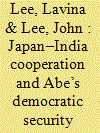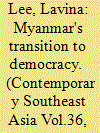| Srl | Item |
| 1 |
ID:
146704


|
|
|
|
|
| Summary/Abstract |
Upon assuming the leadership for the second time in December 2012, Japanese Prime Minister Shinzo Abe called for the formation of a “democratic security diamond (DSD)” to safeguard the maritime commons stretching from the Indian Ocean region to the western Pacific with four of Asia’s most prominent maritime democracies — Australia, India, the United States and Japan — forming the points of the diamond. The Japanese leader explicitly called on these states to join forces to oppose Chinese “coercion” and to defend peace, stability and freedom of navigation within the diamond. The rehashed quadrilateral concept raises a number of interesting issues relevant to the future security environment of the Indo-Pacific, and for Southeast Asia in particular. This article looks at Abe’s idea of the DSD, why Japan has recently advocated for its formation, and why the United States, India and Australia are targeted as the potential members. The article then looks at the Abe government’s greater willingness and capacity to play a meaningful strategic role in East Asia, applied to a DSD context. This is followed by an examination of Japan’s interest in deepening cooperation with India and possibly seeking Indian support for the quadrilateral idea. It then assesses what role India might play and New Delhi’s likely level of interest in joining such a grouping. Finally, the article argues key players in Southeast Asia will remain ambivalent about the prospect of a DSD founded on a burgeoning Japan–India bilateral relationship.
|
|
|
|
|
|
|
|
|
|
|
|
|
|
|
|
| 2 |
ID:
134034


|
|
|
|
|
| Publication |
2014.
|
| Summary/Abstract |
In the mid-1990s, India faced considerable criticism for abandoning its strong support for pro-democracy forces in Myanmar. Instead, New Delhi chose to pragmatically engage the ruling military junta in order to pursue a number of key security, energy, economic and geostrategic interests that could not be achieved without its cooperation. The results of this change of approach have been modest, and as Myanmar transitions to democracy New Delhi hopes that new opportunities to progress these interests will emerge, rather than new obstacles. This article assesses whether a prospective National League for Democracy (NLD) led government will have the capacity to eradicate Indian insurgent groups (IIGs) operating in Myanmar's territory, be responsive to initiatives to expand trade between the two countries - particularly with India's northeastern states - and be more open to Indian investment. It argues that while the NLD is committed to greater economic liberalization and a closer economic relationship with India, Myanmar will not be an attractive market for Indian firms for some time (outside of the resource sector) until liberal institutions and open competitive practices are more firmly established. This article also argues that the NLD lacks a credible plan to bring an end to the country's long running ethnic insurgencies, and will not have the capacity to comprehensively crack down on IIGs.
|
|
|
|
|
|
|
|
|
|
|
|
|
|
|
|